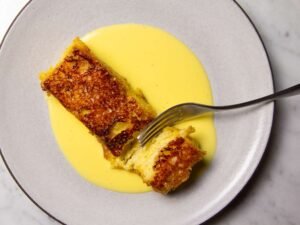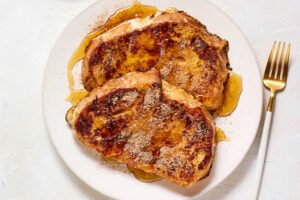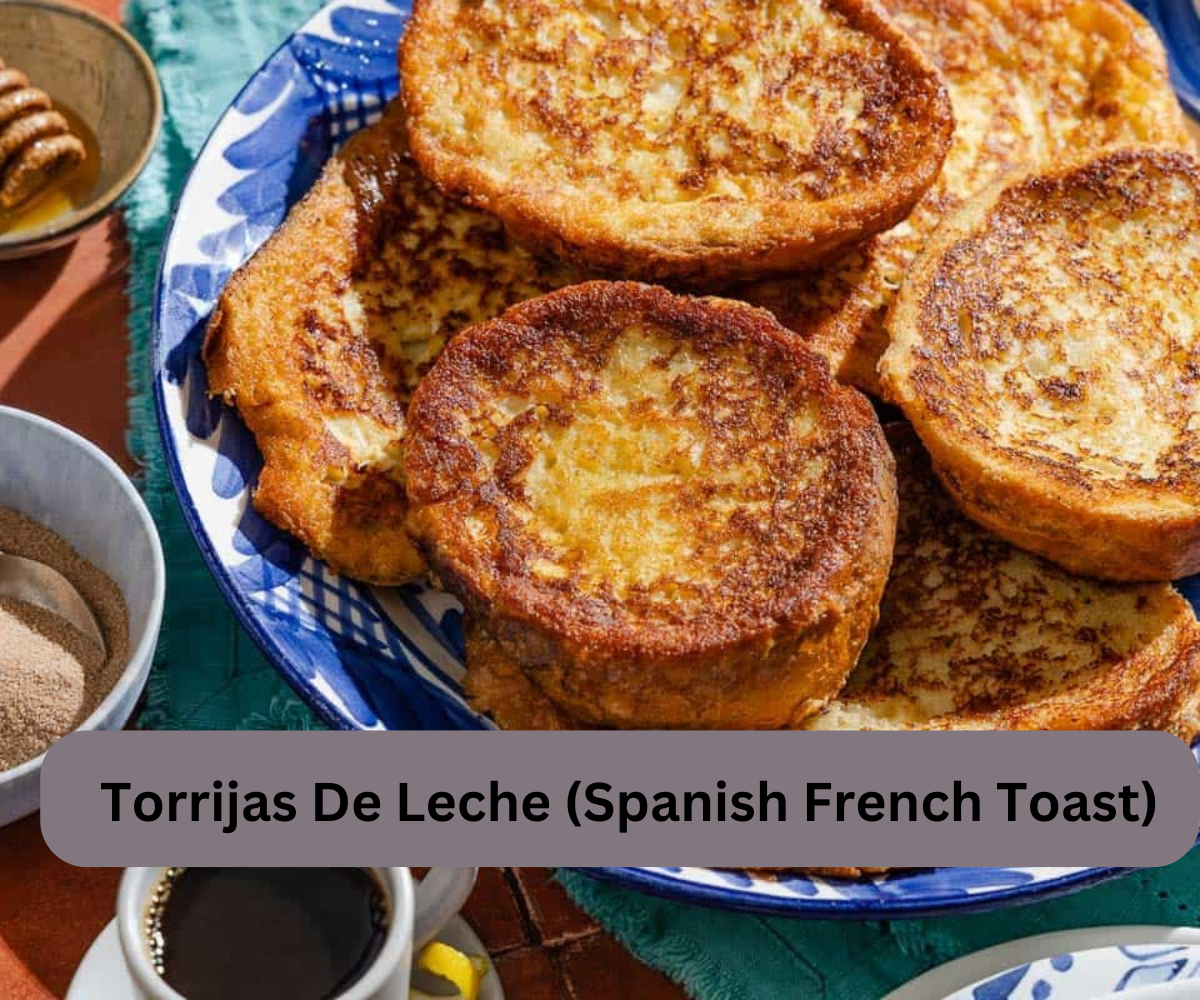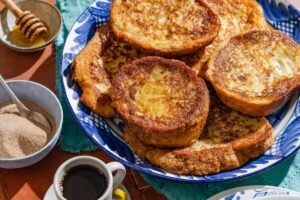Torrijas are indeed a delightful Spanish treat, often enjoyed during Holy Week. Here’s a detailed recipe you can try:

Torrijas Recipe
Ingredients
- 1 loaf of day-old bread (preferably a rustic or country-style bread)
- 2 cups whole milk
- 1 cup heavy cream
- 1 cup sugar, divided
- 1 cinnamon stick
- Zest of 1 lemon
- Zest of 1 orange
- 4 large eggs
- Extra virgin olive oil for frying
- Ground cinnamon for dusting
- Honey for drizzling
Instructions
- Prepare the Milk Mixture:
- In a saucepan, combine the milk, heavy cream, 1/2 cup of sugar, cinnamon stick, lemon zest, and orange zest.
- Heat over medium heat until the mixture is hot but not boiling. Remove from heat and let it cool slightly.
- Soak the Bread:
- Cut the bread into thick slices, about 1 inch thick.
- Arrange the bread slices in a shallow dish or tray.
- Pour the warm milk mixture over the bread, ensuring all slices are well soaked. Let the bread sit for about 10-15 minutes to absorb the milk, turning the slices occasionally.
- Prepare the Egg Mixture:
- In a separate bowl, beat the eggs.
- Heat the Oil:
- In a large skillet, heat the extra virgin olive oil over medium heat until shimmering.
- Fry the Torrijas:
- Dip each soaked bread slice into the beaten eggs, allowing any excess to drip off.
- Carefully place the egg-coated bread slices into the hot oil and fry until golden brown on both sides, about 2-3 minutes per side.
- Transfer the fried torrijas to a paper towel-lined plate to drain any excess oil.
- Finish and Serve:
- While still warm, sprinkle the torrijas with the remaining sugar and a light dusting of ground cinnamon.
- Drizzle with honey just before serving.
Tips
- Day-old bread: Using day-old bread helps the slices absorb the milk mixture without falling apart.
- Oil temperature: Ensure the oil is hot enough for frying, but not smoking. This ensures a crispy exterior and a soft, custardy interior.
Enjoy your homemade torrijas as a sweet brunch, dessert, or an indulgent afternoon snack!
Semana Santa, or Holy Week, in Spain stands as a monumental event that transcends mere religious observance, becoming a vibrant cultural phenomenon deeply rooted in history and tradition. Spaniards and visitors alike immerse themselves in a week-long journey marked by solemn processions, elaborate rituals, and culinary delights that celebrate both faith and community.
At its heart, Semana Santa is a time of reflection and reverence, commemorating the Passion, Death, and Resurrection of Jesus Christ. Throughout Spain, cities and towns come alive with intricately planned processions, where hooded penitents, carrying heavy floats depicting scenes from the Passion, solemnly march through narrow streets lined with spectators. The atmosphere is charged with a mix of solemnity and festivity, as centuries-old traditions are upheld with unwavering devotion.
Culinary traditions during Semana Santa are equally rich and significant. Convents, bakeries, and households prepare a variety of sweets that have become synonymous with this time of year. Buñuelos, delicious dough fritters often flavored with anise or orange zest, are a staple during Holy Week. These crispy treats, sometimes filled with cream or chocolate, symbolize the indulgence before the austerity of Lent gives way to the joy of Easter.
Huesos de San Expedito, bone-shaped pastries named after the patron saint of urgent causes, are another popular Semana Santa delicacy. These delicate pastries, often dusted with powdered sugar, are enjoyed as a symbolic reminder of mortality and the fleeting nature of life—a contemplative theme interwoven throughout Holy Week.
One of the most iconic culinary creations of Semana Santa is the Mona de Pasqua, a cake traditionally adorned with hard-boiled eggs. This elaborate confection varies regionally but typically features a sweet bread base intricately decorated with dyed eggs, symbolizing rebirth and renewal—a fitting metaphor for Easter’s promise of new beginnings.
Beyond the religious significance, Semana Santa holds immense cultural value for Spaniards. It is a time for families to come together, for communities to bond over shared traditions, and for visitors to experience the depth of Spanish heritage firsthand. Whether one participates in processions, savors traditional sweets, or simply absorbs the atmosphere of ancient rituals unfolding in modern times, Semana Santa offers a profound connection to Spain’s past and present.
For many, Semana Santa transcends religious boundaries, drawing people of diverse beliefs to witness and partake in a living tapestry of faith, history, and gastronomy. It is a reminder of the enduring power of tradition and the ability of cultural practices to unite and enrich communities across generations.
In conclusion, Semana Santa in Spain is more than a religious observance—it is a vibrant tapestry of history, tradition, and culinary artistry that captivates hearts and minds, inviting all to partake in its profound significance and festive spirit.




